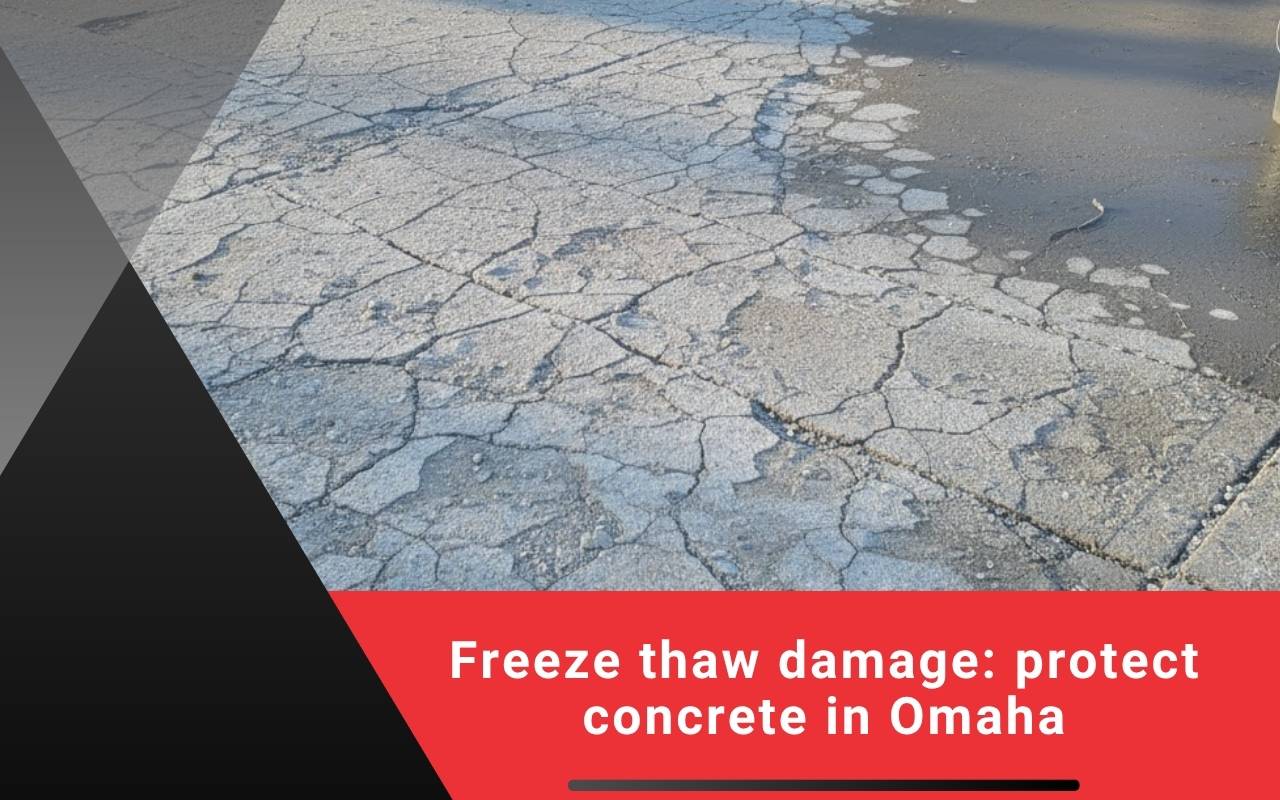BLOG

Freeze–thaw damage: protect concrete in Omaha
Protecting concrete from freeze-thaw damage is vital in Omaha’s harsh winters. Fluctuating temperatures harm roads, driveways, and walks, causing cracks and spalling. This guide explains simple ways to protect surfaces in cold months. We review concrete sealing and the impact of road salt damage, so your slabs handle winter better.
The constant freeze-thaw cycle hurts appearance and strength. Early action prevents bigger repairs. Whether you live in Bellevue NE or elsewhere in Omaha, preparing concrete for winter keeps it durable. Freeze Thaw Concrete Omaha solutions make care easier and results stronger.
Understanding Freeze-Thaw Damage on Concrete Surfaces
Water enters small pores and cracks. When temperatures drop, it freezes and expands about 10%, pushing on the concrete. Repeated cycles cause cracks, scaling, and concrete spalling. This is worse when meltwater refreezes overnight, making Freeze Thaw Concrete Omaha a major concern for owners.
Tiny fractures widen each cycle, letting in more water and speeding damage. Deepening cracks weaken load capacity. Without help, problems multiply and repairs rise. By understanding moisture and temperature shifts, Omaha homes and businesses can avoid costly resurfacing with practical steps.
Importance of Protecting Concrete in Omaha’s Harsh Winter Climate
Omaha often swings between freezing nights and warmer days, perfect for freeze-thaw cycles. Snow followed by quick melts floods slabs and fills pores. Each thaw reloads water; each freeze expands it, slowly breaking down surfaces.
Nearby Bellevue NE sees the same risks. Driveways, lots, and patios can become uneven and unsafe. Plan ahead with winter protection and timely fixes. Freeze Thaw Concrete Omaha planning reduces hazards and expensive repairs.
Signs of Freeze-Thaw Damage on Concrete
Spot issues early to limit costs. Look for thin cracks, rough patches, and flaking. These signs show water entered and expanded inside the slab. Early fixes beat full replacements.
Surface flakes or pits signal concrete spalling.
Loose fragments near edges or joints.
Wider cracks after cold nights.
Uneven spots creating trip risks.
Effective Measures for Protecting Concrete Surfaces
Act before winter. Seal hairline cracks with durable filler to block water. Improve drainage so meltwater does not pool. Add expansion joints to handle movement without cracking. During mild spells, remove excess snow to reduce soaking.
Targeted crack sealing and joint care.
Grade and drain away from slabs.
Temporary breathable covers during storms.
Schedule work with Freeze Thaw Concrete Omaha priorities.
For timing tips, see best time to seal concrete in Nebraska.
The Role of Concrete Sealing in Preventing Freeze-Thaw Damage
Quality sealers fill surface pores, repel water, and reduce salt penetration. In Omaha, services often use silane or siloxane that resist water while letting moisture escape. Choose thicker, durable seal for driveways; lighter options fit patios and decor.
Apply in late fall when days stay above 40°F for full cure. Learn more at concrete sealing Nebraska. Proper sealing anchors your Freeze Thaw Concrete Omaha plan.
Impact of Road Salt Damage on Concrete
Road salt lowers water’s freezing point to melt ice, but it speeds concrete wear. Saltwater breaks down cement paste and worsens concrete spalling. Repeated use widens small cracks and invites more water inside.
Shovel first; use minimal deicer later.
Try sand or eco deicers to limit harm.
Rinse residues during warm spells.
Fold road salt damage checks into Freeze Thaw Concrete Omaha care.
See seasonal strategies in concrete protection Omaha.
Best Practices for Winter Concrete Maintenance
Clear snow and ice with plastic tools to avoid scratches. Apply small amounts of safer melt products on problem areas only. After a thaw, inspect for new cracks and seal them with flexible patch.
Keep drains clear so water moves away. Note any heaving or settling and schedule a spring check. These habits support Freeze Thaw Concrete Omaha goals and long service life.
Professional Assistance for Concrete Protection in Omaha
Pros can pressure wash, repair cracks, and apply expert-grade sealers for local conditions. In Bellevue NE and Omaha, they understand freeze-thaw and salt challenges. Plans often include routine checks and timely reapplications.
Get tailored advice and fewer surprises by contacting specialists. Start here: contact WM G Caulking. Professional help strengthens your Freeze Thaw Concrete Omaha results.
Frequently Asked Questions
How often should I seal my driveway in Omaha?
Every 2–3 years, or sooner if water no longer beads on the surface.
What is the best deicer for concrete?
Use calcium magnesium acetate or sand; avoid overusing sodium chloride.
Can sealing stop concrete spalling?
Sealing reduces water and salt entry, slowing spalling and future damage.
When is the best time to seal before winter?
Early to mid-fall, with daytime temps above 40°F for proper curing.
Does Freeze Thaw Concrete Omaha affect new slabs?
Yes. New slabs need curing, joints, and sealing to resist early damage.
Long-Term Benefits of Protecting Concrete from Freeze-Thaw Damage
Good protection and routine upkeep extend the life of driveways, walks, and patios. Surfaces look better and boost property value. Safer traction lowers slip risks during icy spells.
Smart care reduces patch costs and prevents major fixes. With steady attention to Freeze Thaw Concrete Omaha, your concrete stays reliable year after year.
Conclusion
Omaha and Bellevue NE face tough winters. By understanding freeze-thaw cycles and road salt damage, you can seal, maintain, and repair on time. Simple steps and expert help deliver strong winter protection.
Investing in these measures saves money, improves safety, and maintains curb appeal. Begin your Freeze Thaw Concrete Omaha plan now for durable, confident performance.

Cracks, gaps, and surface wear weaken concrete, causing costly damage. You need a solution that lasts. That’s where we come in. Our expert team specializes in sealing and caulking, ensuring durable surfaces that withstand time and weather.




